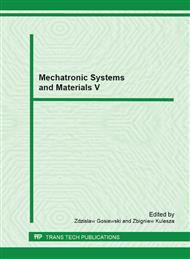[1]
Z. Brojer, Z. Hertz, P. Penczek: Epoxy resins (Ed. WNT, Warsaw 1982) (in Polish).
Google Scholar
[2]
C. Decker, M. Balandier: Degradation of poli(vinyl chloride) by U.V. radiation – I. Kinetics and quantum yields. European Polymer Journal 1982, Vol. 18, p.1085÷1091.
DOI: 10.1016/0014-3057(82)90209-9
Google Scholar
[3]
C. Decker, S. Biry: Light stabilisation of polymers by radiation-cured acrylic coatings. Progress in Organic Coatings 1996, Vol. 29, p.81¸87.
DOI: 10.1016/s0300-9440(96)00630-3
Google Scholar
[4]
D. Kotnarowska: Kinetics of wear of epoxide coating modified with glass microspheres and exposed to the impact of alundum particles. Progress in Organic Coatings 1997, Vol. 31, p.325¸330.
DOI: 10.1016/s0300-9440(97)00090-8
Google Scholar
[5]
D. Kotnarowska: Influence of ambient factors on operational parameters of the protective epoxy coatings for technical equipment. Monograph No. 40 (Ed. of Radom Technical University 1999) (in Polish).
Google Scholar
[6]
D. Kotnarowska: Influence of ageing on mechanical properties of epoxy coatings, Advances in Corrosion Protection by Organic Coatings. Cambridge 1999, p.1÷10.
Google Scholar
[7]
D. Kotnarowska: Influence of ultraviolet radiation and aggressive media on epoxy coating degradation. Progress in Organic Coatings 1999, Vol. 37, p.149¸159.
DOI: 10.1016/s0300-9440(99)00070-3
Google Scholar
[8]
D. Kotnarowska: Types of wear processes of polymeric coatings. Monograph No. 60 (Ed. of Radom Technical University, Radom 2003) (in Polish).
Google Scholar
[9]
D. Kotnarowska: Influence of Ultraviolet Radiation on Erosive Resistance of Modified Epoxy Coatings. Solid State Phenomena 2006, vol. 113 (Mechatronic Systems and Materials), pp.585-588.
Google Scholar
[10]
D. Kotnarowska: Examination of dynamic of polymeric coatings erosive wear process. Materials Science 2006, Vol. 12, nr 2, pp.138-143.
Google Scholar
[11]
D. Kotnarowska: Influence of mechanical factors on surface state of acrylic coatings with nanofillers. Materials Science (Medźiagotyra) 2008, Vol. 14, No. 4, p.337÷340.
Google Scholar
[12]
D. Kotnarowska: Effect of nanofillers on wear resistance of polymer coatings. Solid State Phenomena 2009, vol. 144 (Mechatronic Systems and Materials II), pp.285-290.
Google Scholar
[13]
D. Kotnarowska, M. Wojtyniak: Influence of Ageing on Mechanical Properties of Epoxy Coatings. Solid State Phenomena 2009, Vol. 147-149, pp.825-830.
DOI: 10.4028/www.scientific.net/ssp.147-149.825
Google Scholar
[14]
D. Kotnarowska: Effect of Erosive Particles Velocity on the Intensity of Polymeric Coatings Wear. Solid State Phenomena 2010 (Diffusion and Defect Data) Vol. 165, p.91÷95.
DOI: 10.4028/www.scientific.net/ssp.165.91
Google Scholar
[15]
D. Kotnarowska: Epoxy coating destruction as a result of sulphuric acid aqueous solution action. Progress in Organic Coatings 2010, Vol. 67, Issue 3, p.324÷329.
DOI: 10.1016/j.porgcoat.2009.10.026
Google Scholar
[16]
D. Kotnarowska: Protective Coatings, Radom Technical University Ed. (2010) (in Polish).
Google Scholar
[17]
I. Narisava: Resistance of Polymer Materials. Ed. Chemistry, Moscow 1987 (in Russian).
Google Scholar
[18]
T. Nguyen, D. Bentz, E. Byrd: A study of water at the organic coating/substrate interface. Journal of Coatings Technology 1994, Vol. 66, No. 834, p.39¸50.
Google Scholar
[19]
T. Nguyen, D. Bentz, E. Byrd: Method for measuring water diffusion in a coating applied to a substrate. Journal of Coatings Technology 1995, Vol. 67, No. 844, p.37¸46.
Google Scholar
[20]
T. Nguyen, J. B. Hubbard, J. M. Pommersheim: Unified model for the degradation of organic coatings on steel in a neutral electrolyte. Journal of Coatings Technology 1996, Vol. 68, No. 855, p.45¸56.
Google Scholar
[21]
D. Y. Perera: On adhesion and stress in organic coatings. Progress in Organic Coatings 1996, Vol. 28, p.21¸23.
DOI: 10.1016/0300-9440(95)00585-4
Google Scholar
[22]
S. P. Rigby, R. S. Fletcher, S. N. Riley: Characterisation of porous solids using integraded nitrogen sorption and mercury porosimetry. Chemical Engineering Science 2004 , Vol. 59, pp.41-51.
DOI: 10.1016/j.ces.2003.09.017
Google Scholar
[23]
Paul A. Webb: An introduction to the physical characterization of materials by mercury intrusion porosimetry with emphasis on reduction and presentation of experimental data, Micromeritics Instrument Corp., Norcross, Georgia, (2001).
Google Scholar
[24]
B. Zyska: Problems of microbiological decomposition and microbiological corrosion of materials. Corrosion Protection 1994, No. 4, pp.82-86 (in Polish).
Google Scholar


